OSX Tips: Setting-up a new Mac from an old one or its Backups
Using Migration Assistant on Snow Leopard or Leopard
OSX Tips: Setting-up a new Mac from an old one or its Backups
Using Migration Assistant on Snow Leopard or Leopard
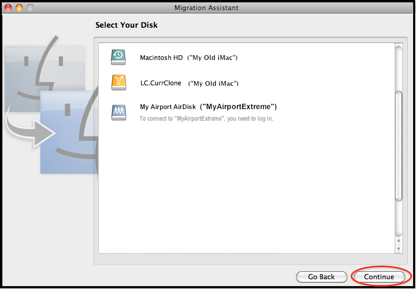
The Select Your Disk window will contain different things depending on your selections above.
If you selected Time Machine backups or other disk, you’ll see backups, other Macs, and "clones."
If you selected Another Mac, you’ll see only other Macs and "clones."
Select the one you want (even if there's only one) then click the Continue button
To use Migration Assistant directly from another Mac, you must connect them, either via FireWire or the same local network (use Ethernet cable if at all possible -- wireless can be excruciatingly slow).
If you use FireWire, be sure to set the "source" Mac to never sleep and, start the old Mac in Target Disk mode. If you're not sure how to do that, see Using Target Disk mode.
To migrate over a network, you may need to upgrade OSX on it, and/or install the "DVD or CD Sharing Setup" software on the old Mac. See Migration Assistant tips and tricks for instructions.
If you’re migrating from Time Machine backups or a "clone," those can be on an internal HD or partition, a USB or Firewire drive, or (on Snow Leopard only) the same local Ethernet or wireless network as the new Mac.
Migrating User Accounts

For each user you select, you can click the disclosure triangle and select or omit the contents of that user’s top-level folders (Desktop, Documents, Downloads, etc.)
Otherwise, you can’t "pick and choose" within any of those folders.
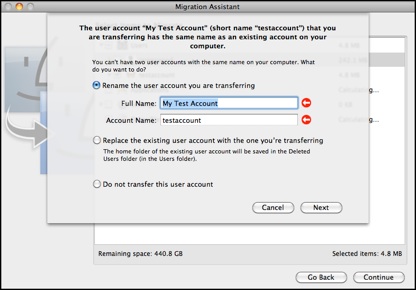
If you try to transfer an existing user account, you’ll get the message shown here.
You can rename the account you’re transferring; replace the existing account (unless you’re logged-in with it); or skip the account entirely.
Note that accounts transferred with Migration Assistant may not be recognized as the same ones as on your backups, or other drives. Thus even though you migrated an account, that same account may not have permission to restore other items from the backups of that account.
Time Machine backups on an internal volume have a gray icon; directly-connected disks a green or yellow icon, and list the name of the volume and computer that was backed-up, not the volume they’re on. Time Machine backups on a network drive have a blue icon, and show the name of the partition and network device they’re on.
Other Macs and "clones" are shown with a gray icon if on an internal HD, a yellow icon if on a directly-connected disk, or a blue icon for a network disk, with the name of the volume and computer they’re on.
If the disk you expect doesn’t appear, and you’re sure it’s connected, you may need to repair it, per Verify or Repair Disk.
For each account selected, the default folders created by OSX (Desktop, Documents, etc.) are all transferred automatically, whether you select them or not. Only the folders that are checked will have their contents transferred.
The exception is the user’s Library folder, which isn’t listed. It, and all of its contents, will be transferred along with the user account automatically.
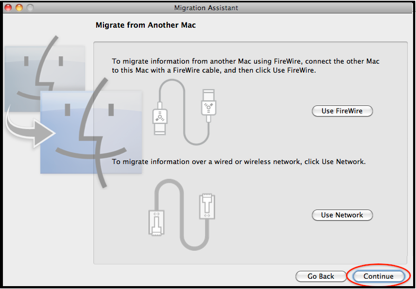
If you select From another Mac, you’ll get a Connection prompt:
If you select Use Firewire, you’ll next see the Select Disk prompt below. It will show only other Macs and "clones" connected via Firewire.
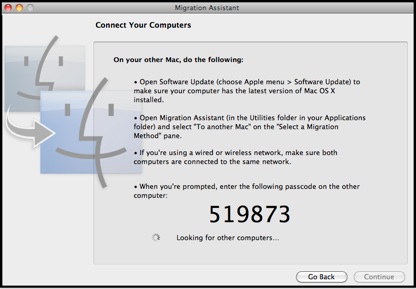
If you select Use Network, you’ll next see the Connect your computers window, with instructions to connect the other Mac.
On that Mac, Via System Preferences > Energy Saver, set the Mac to never sleep.
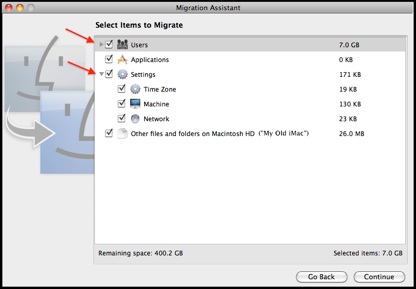
•Users
•Applications
•Settings
•Other Files and Folders
(The Continue button won’t be enabled until it completes "Calculating" all the sizes.)
These are mostly "all or nothing" selections.
In most cases, just leave everything selected, and click the Transfer button (as soon as it completes calculating all the sizes). Migration Assistant will then transfer everything selected.
Migrating Applications
This option will transfer applications only from the top-level Applications folder; not an Applications folder(s) in user home folder(s), or elsewhere. It will also transfer various support files in the top-level Library folder.
You must transfer either all apps or none; you can't select or omit them individually (see Transferring Applications for an explanation).
But Migration Assistant will only transfer apps that don't already exist in the top-level Applications folder on the destination Mac; thus the new Apple apps that came with your new Mac will not be replaced by old ones (and the size shown may be very small). But if the names are different, or they're in different places on the destination (such as sub-folders within Applications or elsewhere), you'll end up with both.
In some cases, there may be a few exceptions:
•If you’re on Snow Leopard, see Mac OS X v10.6, OS X Lion: About incompatible software.
•Some 3rd-party apps may not work properly, or at all, if transferred from an older version of OSX. Check with the maker about compatibility.
•If transferring from a PPC Mac to an Intel Mac, some PPC applications may not work properly, or at all. See this Apple article: Intel-based Mac: Some migrated applications may need to be updated.
•You may have to re-enter serial numbers/purchase codes for some 3rd-party applications.
•Some complex 3rd-party apps that were installed with special installers may need to be reinstalled from the original disc(s) to work properly. Adobe apps are often subject to this.
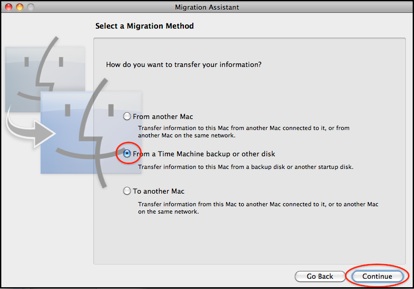
When it starts, you'll see an introduction, then a prompt for your Admin password, then one to select the Migration Method.
If you select From a Time Machine Backup or other disk, you'll next see the Select Your Disk window below. Use this option to migrate from a "clone" on an external HD.
Migrating "Other files and folders on <disk name> <Computer Name>"
This will transfer pretty much anything not covered above:
•Non-system files/folders at the top level of the disk, such as the (empty) Unix Desktop folder, the User Guides and Information alias, the Developer folder (if installed), etc.
•The Shared user folder
There is special handling for duplicates in this category: if the item already exists, the new one will have "(from old Mac)" appended to its name.
The following samples are from Snow Leopard; if you're migrating to Leopard, the windows look a bit different, and those for what data you want to transfer are on separate windows, in a slightly different order.

The migration will take a while, of course, depending on how much data is being transferred, and how. Network transfers will be slower than FireWire, etc.
While it's running, you'll see this window (don't put too much stock in the Time Remaining estimate).
When it finishes, just Quit the app.
If you migrated from a different Mac, and want to use Time Machine to back up the new Mac to the old Mac's backups, when the first one starts you should (on Snow Leopard) get a prompt about using a different Mac's backups. See: Would you like to reuse the backup . . .? for details. On Leopard, Time Machine will start a new set of backups automatically.
Migration Assistant is used primarily to transfer user account(s) and perhaps other things, from one Mac or its backups, adding them to a Mac that's already set up.
Setup Assistant, however, is designed to transfer all or selected things from one Mac or its backups, to set up a new Mac just like the old one.
If there's any doubt about which you need, see: Setting up a new Mac from an old one or its backups.
If you have Time Machine or "clone" backups of the old Mac on an external HD, it's usually simpler and faster to transfer from them, rather than directly from the old Mac. And to transfer directly, you may have to install/upgrade software on the old Mac.
Avoid transferring wirelessly if at all possible -- it's excruciatingly slow and less reliable.
If the old Mac has any user home folders on a separate disk or partition, and/or you want to set the new one up that way, see: Transferring Home Folders not on a Startup volume.
If the Mac you’re setting up is running 10.7 or 10.8, see Using Migration Assistant with Mountain Lion or Lion. It's a bit different from the Snow Leopard and Leopard version covered here. (If you're not sure what version of OSX you're running, click here).
Don't be alarmed by the length of this page: It includes many details that only a few users will need, in a few situations. The usual procedure is actually simple:
•Start the Migration Assistant app.
•Specify whether you want to transfer directly from your old Mac or its backups, and connect to it.
•Specify what you want to transfer (Apps, User Accounts, Settings, etc.).
•Wait while your Mac does all the work (copying your stuff).
•When it's done, you're in business!
See below for step by step instructions, including some unusual circumstances.
If you're transferring directly from a PPC Mac to one running Leopard or the first versions of Snow Leopard (10.6.0 or 10.6.1), there's a small chance of problems, so an extra precaution is recommended: either make a separate full backup of the PPC Mac "just in case," or see A Basic Guide for Migrating to Intel-Macs.
If you have any user accounts on the new Mac with the same name as any you want from the old ones, there's a conflict: they can't both be on the same Mac.
If you don't need any of the new account's data, create a temporary Admin user account, with a name different from any on your backups, log on with it and delete the conflicting account. Then use Migration Assistant to transfer what you want and delete the temporary account. If you do need some data from the new account, copy it elsewhere temporarily, then delete the new account via System Preferences > Accounts. Alternatively, you can migrate the account, but rename it via Migration Assistant, then copy things from the other account.
Note that you cannot "merge" or combine user accounts with Migration Assistant, but you may be able to do it manually. See Transferring Files from one User Account to another.
Before Starting:
•If you anticipate an issue with iTunes authorizations, see About iTunes Store authorization and deauthorization.
•If you use Time Machine, turn it OFF. Everything you migrate to your Mac is considered as changed, so Time Machine will back it all up. If there's a problem with the transfer, you may have to delete some or all of it and transfer it again.
Migrating Settings
If you're already connected to a network, you won't have the Network option.
If the Machine settings are transferred, that includes system-wide settings, such as Time Zone, System Keychain, EnergySaver, Time Machine, and Sharing. Sharing includes the Computer Name. That's easily changed after your new Mac restarts, via System Preferences > Sharing.
Note that Leopard doesn't have the three options; just the single Settings option.